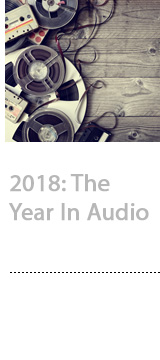
Audio remained an exciting area for programmatic advertisers in 2018 as the medium moved further toward automation.
The podcast industry began to mature this year as growing audiences garnered attention from radio broadcasters, streaming audio giants and big brands. But a lack of available audience data still hinders programmatic and measurement.
Meanwhile, streaming audio and terrestrial radio took big steps toward programmatic adoption in 2018, as Pandora finally launched a programmatic audio capability and terrestrial radio buyers began incorporating automation and targeting into their buys.
Here’s a look at how digital audio evolved in 2018.
Podcast push
The audio advertising industry’s attention shifted from music streaming to podcasting in 2018.
With 28% of Americans listening to podcasts monthly, according to Edison Research, what had once been the territory of direct response advertisers began to see major brand advertisers stepping in.
Hit shows drew record audiences. Wondery’s true crime drama “Dirty John” was downloaded over 15 million times within the first three months of its release, and The New York Times’ daily news podcast, “The Daily,” boasts 5 million monthly listeners.
To be fair, 2018 simply continues an upward trajectory. The podcast advertising market grew 86% by the end of 2017 to $317 million, according to the IAB and PwC, which predict it will hit $659 million by 2020.
As the money came in, the podcast industry began to consolidate – yet another sign of maturation. In August, PRI merged with the second largest podcast network, PRX. And in September, iHeartMedia shelled out $55 million for podcast network Stuff Media, which sees 61 million monthly downloads.
“The real opportunity to bring the full potential of podcasts to the mainstream still lies ahead,” iHeartMedia chairman and CEO Bob Pittman said in a statement.
Digital audio giants also got into the game. Spotify expanded its content library in 2018, becoming the second-largest podcast listening platform. And Pandora launched the podcast genome project, a search and discovery algorithm that makes it easier for users to find new content – and advertisers to reach their audiences – through its platform.
Slow but steady progress in measurement and programmatic
As the podcast industry gained steam in 2018, it also overcame some technical hurdles.
The IAB released a podcast measurement compliance program in December to corral the industry around standard metrics. And NPR hopes to help advertisers measure impressions with its Remote Audio Data protocol, also released in December, which embeds code into podcasts that send listening events back to advertisers.
But Apple, which still commands over half of all podcast listening, hasn’t announced support for the RAD, leaving a black hole on measurement. (Apple released an analytics tool in 2017 that showed performance data, but not at the impression level.)
leaving a black hole on measurement. (Apple released an analytics tool in 2017 that showed performance data, but not at the impression level.)
As for programmatic, the buying method is still nascent in podcasting but the technology is advancing. The podcast network Panoply launched a programmatic marketplace in July, and Acast raised $35 million in December to advance its programmatic private marketplace.
But most publishers sell inventory directly and fear programmatic will ruin the quality of podcast ads and ignite a race to the bottom on pricing.
“There’s a risk people will roll out programmatic with prerecorded ads,” said Hernan Lopez, CEO of podcast network Wondery, in a January interview with AdExchanger.
Programmatic traction in streaming audio and terrestrial radio
Both digital streaming audio and terrestrial radio embraced automation on a wider scale in 2018.
Spotify, which launched programmatic audio capabilities in 2016, launched a self-serve platform in 2018 and continued to hone its expertise in programmatic sales. When the company went public in March, it revealed that over the past two years, programmatic buying has grown to be a quarter of its revenue.
Meanwhile Pandora, which was slower to adopt programmatic audio, made a few bold moves this year cementing its status as a leader in the space. By acquiring AdsWizz for $145 million in March, Pandora gained ownership of the industry’s largest programmatic audio exchange. (That didn’t sit well with Spotify, which pulled its inventory off AdsWizz’s exchange after the transaction closed.)
Outside of the big platforms, programmatic digital audio became easier to buy on the open exchange across mainstream DSPs , while dynamic audio creative emerged as more accessible capability.
But despite all of the progress in digital audio, radio broadcasters didn’t take a back seat to programmatic progress in 2018.
Programmatic radio platform Jelli in particular had a big year. Weeks after Horizon Media announced in November it would use the programmatic radio platform to place all of its upfront buys, iHeartMedia acquired the company for an undisclosed sum.
“Every major radio group in the United States is using Jelli to sell programmatically,” said Jelli CEO Mike Dougherty said in a February interview with AdExchanger. “That scale is significant.”
This post was syndicated from Ad Exchanger.


More Stories
WBD Introduces Out-of-Home Member Plan as It Begins Max Password Crackdown
Deep Blue Is Building a Women’s Sports Yacht Club at Cannes
Sinclair SVP of Station Operations to Retire in June